Essential Swimming Training Techniques for Surfboarders
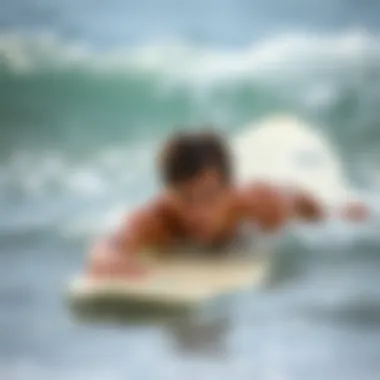
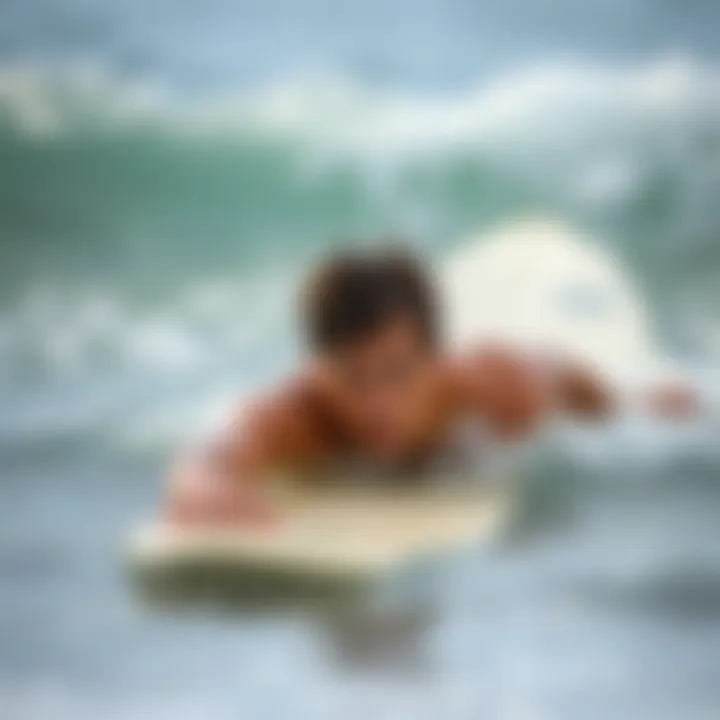
Intro
In the realm of surfboarding, the aquatic landscape poses both thrilling challenges and unique demands. While mastering the art of riding a wave is essential for any surfer, the foundation of surfing prowess often lies in one’s swimming abilities. By honing your swimming training techniques, not only can you enhance your stamina, but you'll also build the skill set necessary for tackling oceanic conditions. The link between swimming and surf performance is an intricate dance of technique, endurance, and adaptability to the ever-changing surf environment. This guide aims to peel back the layers and provide you with precise methods to elevate your aquatic capabilities, ensuring you ride your board with confidence.
Surfing Techniques
Mastering the Basics
Before diving into the undulating waters, it's imperative to have a grip on the fundamental swimming techniques. Surfboarders, akin to seasoned fish in water, must understand how to float, swim efficiently, and navigate through rough seas. Focus on developing a strong freestyle stroke, where an effective breathing pattern can dramatically increase your endurance. To start:
- Body Position: Your body should be streamlined; head down, body flat—think of making a pencil shape as you swim. This reduces drag, allowing you to move through water more fluidly.
- Kicking Technique: Use short, quick kicks from the hips rather than long, sweeping movements. This helps conserve energy.
- Breathing: Practice bilateral breathing to maintain rhythm. Alternate your breath from side to side, providing balance and avoiding neck strain.
Regularly incorporate drills such as pull buoy exercises to improve your upper body strength, allowing you to execute powerful paddle strokes while on your board.
Advanced Maneuvers
Once you’ve conquered the basics, it’s time to elevate your swimming game with advanced techniques tailored specifically for surfboarders. At this stage, you’re looking to transform your swimming into an extension of your surfing skills. Consider the following:
- Interval Training: This method pushes your cardiovascular limits and mimics the exertion needed when paddling out through waves. Mix high-intensity lengths with low-intensity recovery periods.
- Open Water Swimming: Practice in conditions similar to surfing—choppy waters, currents, and wind. This not only builds endurance but also enhances your navigation skills.
- Dolphin Kicks: Integrate dolphin kicks into your training to simulate the movements needed when catching waves. This powerful stroke helps with rapid acceleration and can be an ace in your surfing repertoire.
Implementing these techniques can lead to enhanced swim efficiency, translating to quicker paddling, easier duck diving, and a seamless connection to the wave face.
"An adept swimmer becomes a fearless surfer; skill in the water breeds confidence in riding the tides."
End
Elevating your surfing experience is not just about riding the crest of a wave; it begins with the skill of swimming. Understanding the techniques that cater specifically to surfboarders allows for a more enjoyable and secure session in the ocean.
Explore a variety of resources that delve into swimming techniques suitable for surf enthusiasts. Websites such as Wikipedia and Britannica offer extensive insights into swimming methods, while forums like Reddit provide community advice and personal experiences.
Integrate these methods into your training regimen, immerse yourself in the ocean arts, and witness firsthand how impeccable swimming skills amplify your connection to the waves.
Foreword to Swimming in Surfboarding
Surfing might seem all about the waves and the board, yet at its core, successful surfing hinges on a strong foundation in swimming. As a surfer, understanding and mastering swimming techniques is not just advantageous; it's essential. Swim training equips you with the skills needed to navigate the ocean confidently, enhancing safety and performance simultaneously.
Swimming in the context of surfing covers more than just the act of keeping afloat or propulsion through water. It introduces a host of tactical advantages. The ability to swim efficiently allows surfers to react swiftly in challenging conditions, handle emergencies, and extend their time in the water without exhaustion. Moreover, proficient swimming skills translate directly into better wave riding skills and overall performance.
The ocean is unpredictable. A strong swimmer will always have an edge when things turn sideways.
Adopting swimming training also fosters resilience and builds endurance. Long sessions in the water improve not only your physical stamina but also your mental fortitude, vital for facing the often daunting currents and waves. By honing both your swimming and surfing abilities, you're fundamentally elevating your game when it comes to that exhilarating ride on the crest of a wave. You're not merely engaging in a sport; you're embracing a lifestyle that fuses passion with skill, ensuring that you can dodge the unexpected like a pro.
In this article, we will explore the multifaceted role of swimming in the world of surfboarding, highlighting key swimming techniques and drills that every serious surfer should master. We aim to break down the various components of swimming training, focusing on what it takes to enhance your aquatic capabilities and ultimately your surfing performance. By understanding the intricate dance between swimming and surfing, you’ll see how they intertwine to create a more fulfilling and safer experience in the water.
Understanding Swimming Fundamentals
Swimming fundamentals form the backbone of any surfer's aquatic skill set. In this article, we underscore the necessity of mastering these basic swimming skills, which not only boost performance in the water but also enhance safety and enjoyment while surfing. A solid foundation in swimming is pivotal, as it facilitates smoother transitions from swimming to paddling and even jumping onto a surfboard. When surfers are proficient in these essentials, it allows them to focus more on their surfing techniques rather than battling against the water's challenges.
Basic Swimming Techniques
Breathing Techniques
Breathing is often overlooked but plays a crucial role in swimming effectively. The ability to exhale underwater and inhale quickly when surfacing minimizes drag and maximizes oxygen intake. One important characteristic of effective breathing techniques is rhythm—maintaining a steady pattern can lead to more efficient strokes. Additionally, mastering the art of bilateral breathing, where a swimmer alternates breathing sides, improves balance and stroke symmetry, a crucial advantage for surfers who often need to pivot quickly. However, without proper practice, some might struggle with anxiety when surfacing for air, which can hinder their overall swimming development.
Body Position
Proper body position is critical to reducing drag while swimming. Keeping the body flat and streamlined in the water allows for smoother movement and less resistance. A key aspect here is aligning the hips closer to the surface, which enables a more effective kick. This body position not only aids in short bursts of speed necessary for catching waves but also significantly conserves energy during longer swims. Still, beginners may find it challenging to maintain this position consistently, leading to fatigue. Adjusting one's posture can take time, but it is well worth the effort.
Stroke Mechanics
Stroke mechanics encompass how a swimmer uses their arms and legs to propel through the water. A primary consideration is the technique used in the freestyle stroke, which should incorporate high-elbow recovery and a powerful pull. This is not just about speed; it's about efficiency. A good stroke can translate directly to better paddling power on the surfboard, allowing for quicker responses to incoming waves. While most surfers might feel comfortable with basic freestyle strokes, the intricacies of effective stroke mechanics could be the tipping point in competitive scenarios. Learning the nuances may take effort, but every bit of trouble can pay dividends when adrenaline is surging on a wave.
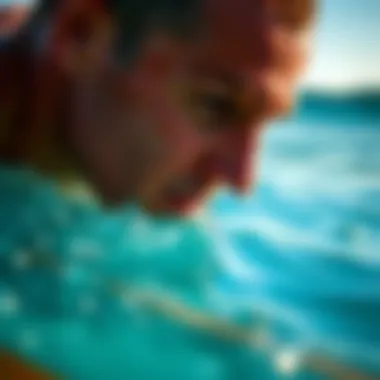
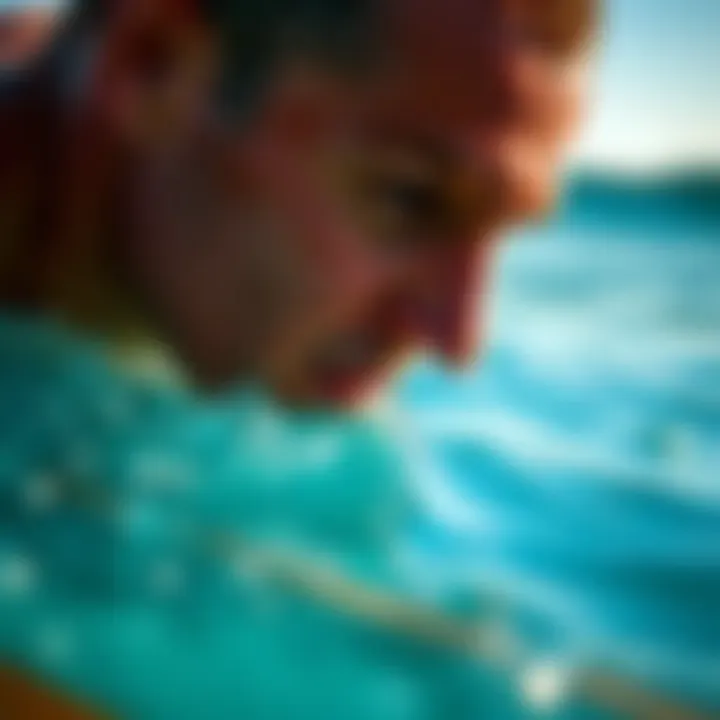
Water Safety Skills
Understanding Rip Currents
A sound understanding of rip currents is vital for surfers. These powerful waterways can be deceptive and hazardous, especially for those inexperienced with their dynamics. Recognizing how to identify these currents—such as looking for differences in water color or surface texture—acts as a lifesaver. The ability to read water conditions not only keeps surfers safe but also enriches their overall surfing experience. Nevertheless, some might still find themselves caught unexpectedly, which stresses the need for constant vigilance and education about local surfing conditions.
Survival Floating Techniques
Survival floating techniques teach an individual how to remain afloat effectively without exhausting themselves. This can include the starfish or the back float methods, which are particularly practical for surfers who may find themselves in precarious situations after falling off a board. Key characteristics include minimizing energy waste while maximizing buoyancy, which is essential in the often tumultuous ocean environment. Many surfers may dismiss these skills as unnecessary, yet they can be invaluable during unexpected surf incidents. Knowing how to float can be a game-changer, helping a surfer recover composure before deciding on the next steps.
"Mastering the fundamentals of swimming can mean the difference between a mediocre surf session and catching the wave of your life."
Developing Key Swimming Skills for Surfers
When it comes to surfing, the ability to navigate through water is paramount. Not only does strong swimming capability enhance your performance on a surfboard, it can also be your lifeline in challenging conditions. Building your swimming skills prepares you for what the ocean might throw at you, ensuring that you can maintain control and stability while out in the swell. Let’s delve into specific swimming training techniques that can help surfers hone their aquatic capabilities.
Endurance Training for Surfers
Long Distance Swimming
Long distance swimming is all about stamina. Engaging in this type of training offers surfers the endurance they need to paddle through waves and handle extended sessions in the water. This practice builds muscle memory and, importantly, develops cardiovascular strength. Surfers who include long distance swims in their routines can find themselves better prepared for those lengthy days at the beach—where the ocean demand can be relentless.
One distinguishing feature of long distance swimming is that it encourages a calm and relaxed approach to water. Surfers who practice it often cultivate the mental fortitude to handle tough surf conditions, as they learn to rhythmically manage their breath and movement over prolonged periods. However, it can come with its drawbacks – it may become monotonous and might even lead to overuse injuries if not approached with balance.
Interval Training Strategies
Interval training is another smart tactic for surfers aiming to level up their swimming game. This training style mixes high-intensity effort with periods of rest or low activity. Essentially, it mirrors the bursts of energy a surfer expends when paddling for a wave versus the calmer periods when waiting.
The principle behind interval training is simple yet effective. It provides quick gains in speed and endurance, helping to replicate the unpredictable nature of wave riding. Surfers who incorporate interval strategies in their training can expect to see improvements in both power and agility. A potential con, however, includes the risk of burnout if one is not careful about the intensity of the workouts.
Speed and Agility Drills
Sprint Sets
Speed is key in big surf. Sprint sets are short, high-intensity swimming segments followed by rest periods. They are vital for building quickness and explosiveness in a surfer’s paddle. Imagine this: you spot a perfect wave approaching, and having the speed to get out ahead of the competition can make all the difference.
What sets sprint sets apart is their focus on these fast-twitch muscle fibers, essential for speed and power. This training method is often favored by athletes for its effectiveness in bringing about immediate improvements. But, can it wear a swimmer down? Yup! If done too often without proper recovery, the risk of fatigue increases.
Reaction Time Exercises
Surfers don’t often have the luxury of time when it comes to catching waves. This is where reaction time exercises come into play. These drills are designed to sharpen reflexes and decision-making speed—the very essence of catching a wave.
Engaging in specific drills, such as varying your entry point into the water or doing quick bursts off the wall from a pool, can train the body to respond quicker to changing circumstances in the ocean. The uniqueness of reaction time exercises lies in their adaptability; they can be customized to fit an individual’s skill level and focus area. On the flip side, a surfer might find them challenging and may require a consistent practice approach to see improvement.
"Swimming efficiency can make or break a session, especially when battling currents or waiting for that perfect wave."
Through incorporating these essential drills into a training regimen, surfers can enhance not just their swimming skills, but ultimately their surfing performance as a whole. Perseverance and thoughtful practice turn good surfers into great ones.
Implementing Skill-Specific Drills
When it comes to swimming for surfers, honing specific skills can truly make all the difference. Skill-specific drills serve as a focused avenue to fine-tune the essential movements and techniques surfers need while traversing the waves. This focused approach does not just build strength or endurance but also fosters greater awareness of one's swimming mechanics and how they relate to surfing performance.
Incorporating these drills into a regular swimming routine creates the perfect fusion of water skills that are relevant to surfing. There are several benefits tied to implementing these drills: they enhance stroke efficiency, reinforce body coordination, and even help with breath control. Each unique drill contributes towards a more fluid transition from swimming to paddling on the surfboard, a critical aspect for effective wave riding.
Furthermore, it's important to pay attention to the differences between training in a pool versus open water, as each environment presents unique challenges that amplify the importance of specialized drills. Let's drill down into some of these techniques – the catch-up drill and single arm freestyle for freestyle swimming, as well as backstroke timing and breaststroke glide for integrating various styles into the training regimen.
Freestyle Drills to Enhance Stroke Efficiency
Catch-Up Drill
The catch-up drill is a standout technique that focuses on improving arm stroke efficiency. Essentially, this drill encourages swimmers to extend one arm fully in front while the other stays behind until the hand catches up. This method not only encourages a smoother glide but also promotes better timing in the strokes.
What makes the catch-up drill popular among surfboarders is its clear focus on synchronization and body position, which are critical for effective paddling. Improper timing can lead to wasted energy, so learning to do this drill properly can help conserve strength for those long paddles.
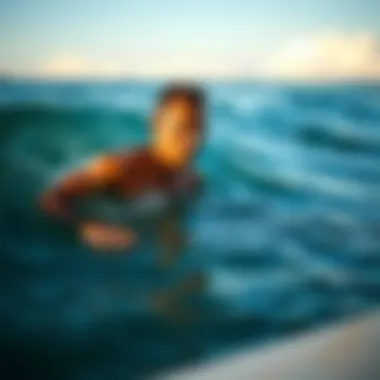

One of its unique features is that swimmers can visualize transitioning from a swimming posture into the active paddling on their surfboards, mimicking the precise movements necessary to catch waves. However, a potential downside is that beginners might struggle with this drill's coordination, leading to frustration if they do not grasp it quickly.
Single Arm Freestyle
Single arm freestyle is another nifty technique that enhances stroke efficiency by letting surfers focus on one arm’s movements at a time. This drill isolates each arm, allowing surfers to identify areas for improvement, whether it's their catch, pull, or recovery phase. This ultimately leads to a more powerful and efficient stroke when in the water.
This method shines because it lends itself to better rotational movements and strengthens each arm independently, rounding out overall performance in the waves. A key characteristic of the single arm freestyle is the ability to slow things down; it’s as if you're training in slow motion, helping to refine skills methodically. However, it might not mimic the flow of traditional swimming enough for some, which could impede full learning benefits.
Backstroke and Breaststroke Integration
Backstroke Timing
Backstroke may seem less related to surfing, yet mastering backstroke timing is crucial for improving a surfer’s overall coordination and body awareness. By focusing on the timing of arm strokes while advocating a strong core, surfers can develop better balance and buoyancy in the water.
This technique encourages swimmers to pay attention to their body position and streamline through the water, key elements that translate to paddle efficiency on a surfboard. The unique advantage is that it enhances the visual perspective of the shoreline and sets a good rhythm that can be beneficial for catching waves. On the flip side, it may require more patience as transitioning from freestyle to backstroke requires skill.
Breaststroke Glide
The breaststroke glide, though often overlooked, offers specific advantages for surfing. This technique emphasizes the importance of gliding efficiently through the water, which can help conserve energy during longer surfing sessions.
The key aspect here is the glide phase, where the face is submerged while the body extends, allowing surfers to catch their breath and maintain a streamlined position. It's an effective choice for those days when paddling can be exhausting. However, the challenge lies in its slower pace which can dissuade some surfers who prioritize speed in their training.
Implementing these skill-specific drills can dramatically enhance surfing performance by sharpening vital aquatic skills essential for those long paddles and wave-catching moments.
Incorporating Swimming Training into Surfing Practice
The integration of swimming training into surfing practice is essential for maximizing performance on the waves. Surfers who build their swimming skills often enjoy enhanced endurance, quicker paddling abilities, and an overall improved comfort level in the water. It's more than just splashing around—it's about becoming one with the ocean, making informed movements, and understanding how to navigate through both calm waters and turbulent surf. By honing swimming techniques, surfers can confidently tackle bigger waves, and even unexpected scenarios that drift them away from their board.
Scheduling Swimming Sessions
Weekly Training Regimen
A structured weekly training regimen can play a crucial role for surfers aiming to bolster their swimming capabilities. A well-thought-out schedule allows surfers to meld swimming workouts seamlessly into their busy lives. This consistent approach helps surfers build foundational skills while preventing burnout. Each week's training could mix various swim styles, focusing not only on technique but also on reaching those endurance goals that are vital for longer sessions on the surfboard.
One interesting aspect of a weekly regimen is that it can be tailored to the individual's needs and targets. Surfing demands diverse skill sets, from explosive energy bursts during paddling to endurance while waiting for the next wave. Scheduling swimming workouts throughout the week can maintain a balanced focus on various areas, allowing surfers to see noticeable improvements over time. However, care must be taken not to overtrain, leading to fatigue or injury.
Synchronizing with Surf Sessions
Harmonizing swimming training with surf sessions is a smart strategy for maximizing both activities. This synchronization means that surfers can use their swimming workouts as a warm-up or cool-down exercise before and after hitting the waves. Moreover, by planning swim sessions before surf outings, athletes can tap into the benefits of improved vitality and reduced muscle fatigue once they step onto their boards.
However, it is not without its unique challenges. Depending on the surf conditions, some days might favor more swimming than surfing, while others would be better suited for just riding the waves. This fluidity in planning demands flexibility and can be a game-changer for adapting training goals according to real-time water conditions.
Utilizing Pool and Open Water Environments
Benefits of Pool Training
Training in a pool offers a controlled environment where surfers can zero in on their swimming techniques without the external factors of tides and waves. The predictability of a pool allows for focused technique work and consistent training without the worries associated with open water, such as currents or waves crashing over.
One key benefit of pool training is the opportunity to work on specific drills that hone skills like breathing, body positioning, and stroke efficiency. By enabling surfers to concentrate on these elements, pool sessions can markedly enhance their overall performance in the sea. However, it is important to note that while pools are fantastic for skill development, they can lack the unpredictability and varied conditions of the ocean, making it essential to incorporate open water sessions into the training mix as well.
Challenges of Open Water Swimming
Open water swimming, while incredibly beneficial, comes with its own set of challenges. Surfers venturing into the ocean must navigate waves, currents, and varying visibility conditions. These elements make for an unpredictable environment that requires swimmers to adapt quickly and remain resilient.
One prominent challenge is the psychological aspect—many swimmers, especially those who train primarily in pools, may feel overwhelmed by the chaos of open water. It can be easy to lose focus when dealing with chop and swells. Nevertheless, overcoming these hurdles is essential for developing a surfer's confidence in the ocean and enhancing their performance overall. The key is to recognize these challenges and incorporate strategies to tackle them while preserving the agility and stamina built during pool sessions.
To enhance surfing skills, incorporating swimming training in a structured and balanced manner is vital.
Ultimately, merging swimming techniques with surfing practice not only optimizes performance but allows athletes to develop a deeper bond with the aquatic world. As surfers combine pool training with the raw challenges of the ocean, they prepare themselves to ride every wave with skill and confidence.
Monitoring Progress and Adjustments


In the realm of swimming training for surfboarders, monitoring progress and making adjustments play a crucial role in reaching peak performance. While most surfers might think the ocean is the best teacher, it’s often the pool sessions that provide a clear baseline to assess improvement. This oversight is particularly vital when considering the fluctuating conditions of surfing and the various swimming techniques involved.
When one zeroes in on their swimming abilities, keeping track of progress helps in identifying what works and what doesn't. It reflects a surfer’s dedication to their training regimen. By measuring improvement, adjustments can be made proactively, ensuring that the effort focuses on the areas that yield the best results.
"What gets measured gets improved."
It's not just about logging laps; it's about understanding stamina, speed, and stroke efficiency. Surgeons aren't the only ones who need to be precise—surfboarders require exactness and refinement in their training as well. Here’s how we can break it down into clear categories: assessing skills and adjusting the training focus.
Assessing Skill Improvement
Time Trials
Time trials are a specific method of tracking speed and efficiency in swimming. They provide a tangible measure of progress, allowing surfers to challenge themselves periodically. For surfboarders, the uniqueness of time trials lies in their ability to simulate the stamina needed when paddling out to catch waves.
Key characteristics of time trials include:
- Objective Measurement: Time trials offer a straightforward quantifiable metric to assess performance.
- Setting Benchmarks: They help set benchmarks against which future performances can be compared.
- Consistency: Regularly timed swims build discipline and encourage goal setting.
The unique feature of time trials is their adaptability; they can be conducted in both the pool and open water to reflect real-world conditions.
Advantages of time trials are plentiful:
- Boosts motivation by creating clear objectives.
- Helps identify areas needing focus—be it speed or endurance.
However, a disadvantage might be the potential for placing undue pressure on swimmers who might not excel in timed environments. Nevertheless, they are a popular choice for measuring improvement.
Technique Videos
Technique videos serve as another indispensable tool in the assessment of swimming skills. They provide a visual representation of one’s form and efficiency in the water. By analyzing these recordings, surfers can pinpoint flaws in their strokes and make adjustments accordingly.
Key characteristics of technique videos include:
- Visual Feedback: They allow swimmers to see what they might not feel in the water.
- Comparison: Videos can be cross-referenced with professional swimmers to identify areas needing enhancement.
The unique aspect of technique videos lies in their ability to breakdown each stroke, delivering visual cues where adjustments are necessary.
Advantages of using technique videos encompass:
- Immediate feedback on swimming style.
- Helps build muscle memory by reinforcing correct techniques.
On the flip side, over-reliance on videos without proper understanding could lead to confusion, especially for those new to swimming. Yet, they remain a beneficial strategy for refining swimming technique.
Adjusting Training Intensity and Focus
With the foundation laid in skill assessment, the next vital step is adjusting training intensity and focus. Surfers need to tailor their training routines based on their assessments to ensure they optimize their practice sessions.
Adjustments should consider factors such as:
- Individual Goals: Are you looking to enhance speed, endurance, or technique? Understanding personal goals can guide how you adjust sessions.
- Feedback Mechanisms: Utilize results from time trials and video assessments to fine-tune your training focus consistently.
By keeping an open mind and being willing to adapt training intensity, surfers can avoid plateaus and maximize their water skills. Consistency paired with informed adjustments leads to better surfing performance in the waves.
Culmination: The Significance of Swimming in Surf Culture
It’s no secret that swimming is intimately woven into the fabric of surf culture. The oceans’ waves are majestic, yet they present unique challenges. In this context, swimming is not just a skill; it’s a fundamental component that contributes significantly to a surfer's overall performance and safety.
Enhancing Overall Surfing Performance
When you think about it, the ability to swim effectively can make or break a surf session. Surfers constantly find themselves in unpredictable environments where currents, waves, and wind can change in a heartbeat. A strong swimming foundation allows surfers to paddle out with confidence, catch waves more easily, and maintain stamina throughout their session. The benefits cannot be overstated:
- Powerful Paddling: Swimming builds upper body strength, essential for paddling out against the waves. A surfer with efficient stroke mechanics in swimming will find it easier to navigate turbulent waters.
- Better Wave Selection: Fluency in swimming translates to enhanced awareness of one’s surroundings. Surfers become adept at positioning themselves to catch the perfect wave instead of battling against the tide.
- Enhanced Endurance: Regular swimming training increases cardiovascular fitness, enabling surfers to tackle longer sessions without fatigue setting in too soon.
As one seasoned surfer remarked, “When I’m in the water, swimming gives me the confidence to take challenges head-on.” This mentality fosters a mindset that translates directly to being a more capable and skilled surfer.
Encouraging Lifelong Swimming Skills
Moreover, swimming is a lifetime skill that pays dividends beyond the surfboard. Developing good swimming techniques helps instill a sense of comfort in the water, fostering a healthy respect for the ocean's power. Not to mention, it promotes safety for both the individual and those who may surf around them.
- Survival Skills: Having effective swimming skills can literally save lives. Familiarity with the ocean also imparts a greater understanding of how to handle rip currents or distressing situations.
- Bridging Communities: Swimming opens doors to connect with others who share the same passion for water sports. Many surfers find camaraderie through swimming, forming tight-knit communities.
- Promoting a Healthy Lifestyle: Swimming as a lifelong practice encourages overall fitness and mental well-being, reinforcing a bond with the natural world.















